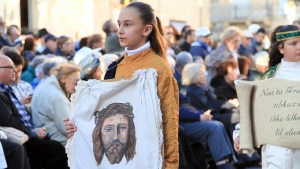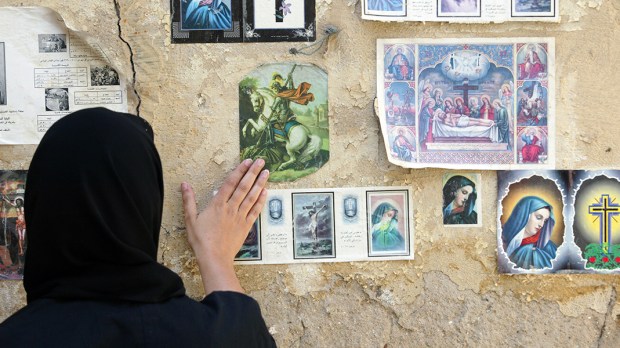In his encyclical Ut Unum Sint, Pope St. John Paul II wrote that “the Church must breathe with her two lungs!” Since I was raised by Egyptian Eastern-Rite parents and educated in Latin-Rite schools and therefore enjoy the richness of both Eastern and Western traditions, I couldn’t agree more with the late Holy Father. (While most Catholics are “Roman” or Latin-rite Catholics, there are 23 Eastern Rite Catholic Churches.)
During Lent and Eastertide, and most especially during the Triduum, my parents lament how much they miss these seasons in Egypt. Being a persecuted minority in the Middle East (since at least the 7th/8th centuries) creates a unity and a sense of urgency to take faith seriously. So while religious freedom was gained immigrating to America, the traditions, the tight-knit sense of community, and the intensity of devotion were somewhat lost.
The way my family lived Good Friday — the commemoration of the crucifixion of Jesus — was of special emphasis. In Egypt, Good Friday is called “Sad Friday” or “Mourning Friday.” My mom recalls the tradition of tasting vinegar on her tongue in remembrance of the scene St. John describes in Chapter 19:29-30 when Jesus fulfills the words of Psalm 69:21: They put gall in my food and gave me vinegar for my thirst.
Eastern Christians — both Orthodox and Catholic — fast and they fast well. My mom chuckles a little about the fasting/abstinence rules in the West because the East basically goes vegan for the entirety of Lent, Sundays included.
Christians are in church all day and often traveling and visiting neighboring churches. It was just part of the culture and everyone was in it together.

Read more:
Hard to believe but yes, there are more martyrs today than in 1st centuries
Other traditions include visiting cemeteries of deceased loved ones, not wearing makeup (Middle Eastern women don’t wear makeup at funerals — they have to look sad and wearing makeup or too much makeup can be seen as disrespectful and unfitting for the occasion), and cooking falafel. My dad recalls how relatives and friends would visit each other all day trading batches.
For those who want to celebrate this year with an Eastern flavor, here are 5 tips from my childhood experience:
Embrace silence and fast from technology.
I love the freedom that comes with saying no to idle chatter, music, television, podcasts, and social media. Even when I was a kid, I loved the sense of solemnity that silence brings. I knew this day was important and special and that it was really about Jesus because of the climate of silence proposed by my parents. It’s an amazing experience to be together in peaceful serenity and quiet.
But do listen to by Fairuz.
These songs will set the mood for mourning. I recently sent these songs to a friend in RCIA and he said even though he doesn’t understand the Arabic language, the music is helping him enter into the feelings Mary must have felt watching her son die. The song Wa Habibi is Mary speaking directly to Jesus as He is enduring His Passion.
Burn frankincense in a thurible.
I absolutely love it when my dad burns church incense and makes the house smell holy. He takes the thurible around to each room and blesses us while he’s doing it. You can find some inexpensive thuribles and incense (not the New Age long stick kind!) at Middle Eastern markets or at the gift shops of Eastern Churches. I would check with the nearest Coptic Church first.
Meditate on the Scriptures, the Good Friday readings in particular.
I will never forget the image of my grandmother reading the Bible with relish.
Pray with an icon or attend an Eastern-Rite service.
If you don’t own an icon, consider purchasing one for your home. They are beautiful and contemplative and incredible prayer tools. Praying with an icon can really help you enter into the less discursive more receptive aspect of praying: Be still and know that I am God. (Psalm 46:10) And if you’ve never attended an Eastern Catholic service perhaps this is the year. It is sublime!
While all this was going on in our household, my mother was busy making Armenian Easter Bread (similar to the Greek and Italian variations). The smell of the delicious bread only heightened our anticipation of the joy awaiting us on Easter Sunday since we weren’t permitted even a bite until the glorious morning of the Resurrection.

Read more:
Blessing your Easter bread: A little-known tradition worth starting
Good Friday is the one day of the year no Masses are celebrated. We permit ourselves to feel the loss and anticipate the joy of our redemption. By properly consecrating the day we not only reflect on these realities but also mysteriously participate in them through our sacrifices:
It is by fixing our gaze on the cross that we learn to perceive experientially the invading Presence and the unavoidable need for grace that gives our life perfection, and gives it joy. It is in Mary that the adoration of our heart finds its example and its form. For the condition of the cross was not just for Christ; Christ’s death on the cross saves the world but not in isolation. It is not alone that Christ saves the world, but by the adherence of each and every one of us to suffering and the cross. St. Paul says it: “In my own body I make up all the hardships that still have to be undergone by Christ, in His Cross and Passion.” (Father Luigi Giussani from his Meditations on the Sorrowful Mysteries)

Read more:
10 Good Friday traditions that would normally take place around the world

